Contemporary Issues in Accounting - Assignment
VerifiedAdded on 2020/04/15
|12
|2321
|67
AI Summary
Contribute Materials
Your contribution can guide someone’s learning journey. Share your
documents today.
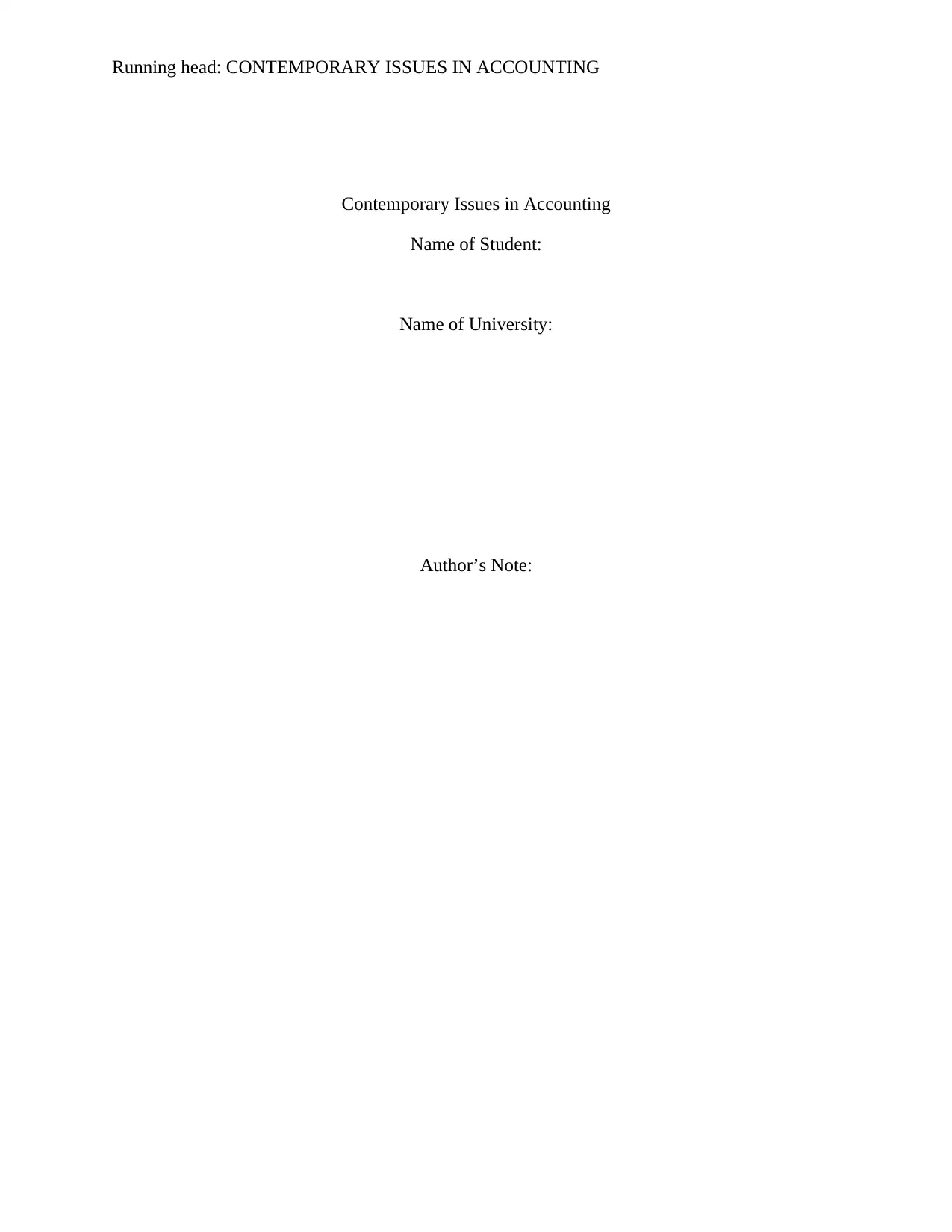
Running head: CONTEMPORARY ISSUES IN ACCOUNTING
Contemporary Issues in Accounting
Name of Student:
Name of University:
Author’s Note:
Contemporary Issues in Accounting
Name of Student:
Name of University:
Author’s Note:
Secure Best Marks with AI Grader
Need help grading? Try our AI Grader for instant feedback on your assignments.
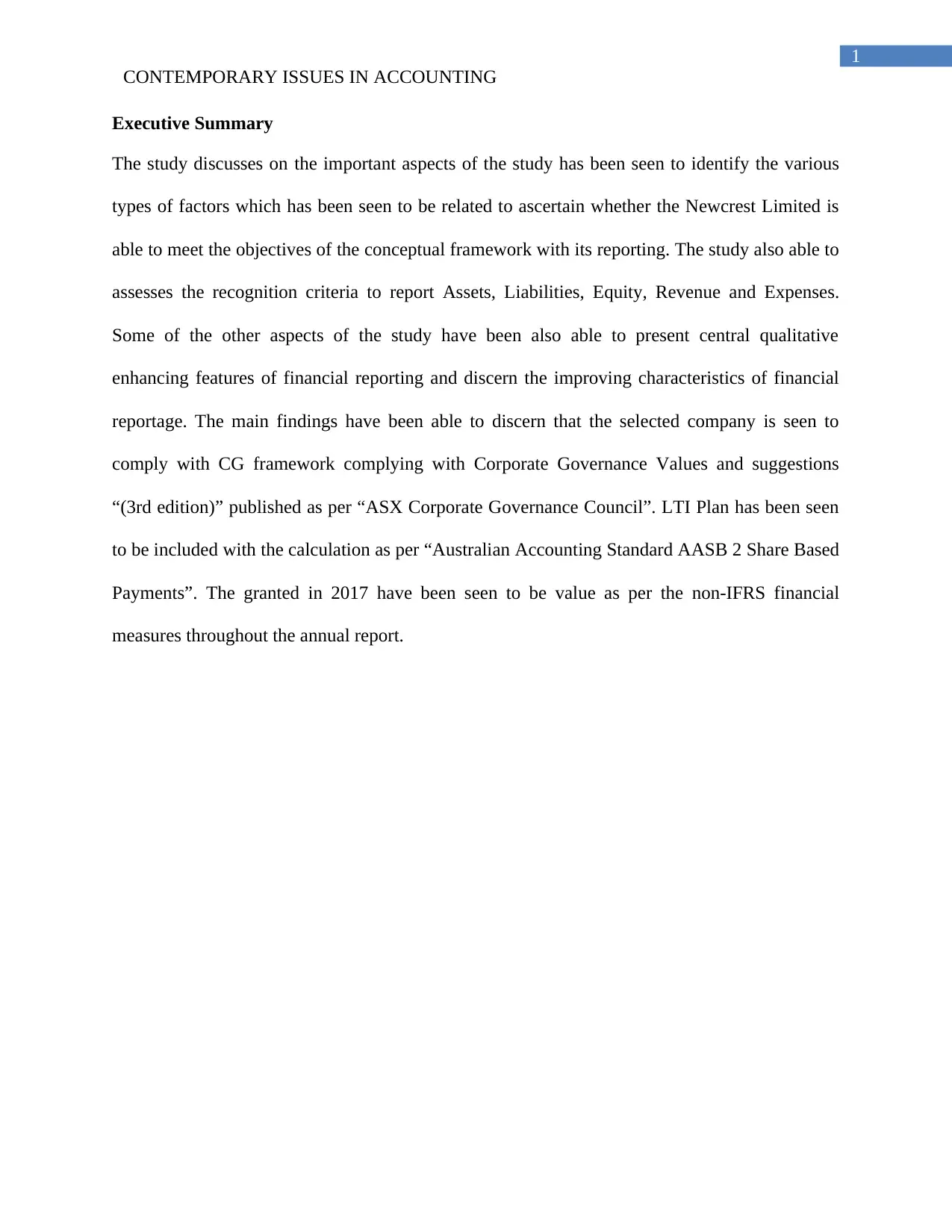
1
CONTEMPORARY ISSUES IN ACCOUNTING
Executive Summary
The study discusses on the important aspects of the study has been seen to identify the various
types of factors which has been seen to be related to ascertain whether the Newcrest Limited is
able to meet the objectives of the conceptual framework with its reporting. The study also able to
assesses the recognition criteria to report Assets, Liabilities, Equity, Revenue and Expenses.
Some of the other aspects of the study have been also able to present central qualitative
enhancing features of financial reporting and discern the improving characteristics of financial
reportage. The main findings have been able to discern that the selected company is seen to
comply with CG framework complying with Corporate Governance Values and suggestions
“(3rd edition)” published as per “ASX Corporate Governance Council”. LTI Plan has been seen
to be included with the calculation as per “Australian Accounting Standard AASB 2 Share Based
Payments”. The granted in 2017 have been seen to be value as per the non-IFRS financial
measures throughout the annual report.
CONTEMPORARY ISSUES IN ACCOUNTING
Executive Summary
The study discusses on the important aspects of the study has been seen to identify the various
types of factors which has been seen to be related to ascertain whether the Newcrest Limited is
able to meet the objectives of the conceptual framework with its reporting. The study also able to
assesses the recognition criteria to report Assets, Liabilities, Equity, Revenue and Expenses.
Some of the other aspects of the study have been also able to present central qualitative
enhancing features of financial reporting and discern the improving characteristics of financial
reportage. The main findings have been able to discern that the selected company is seen to
comply with CG framework complying with Corporate Governance Values and suggestions
“(3rd edition)” published as per “ASX Corporate Governance Council”. LTI Plan has been seen
to be included with the calculation as per “Australian Accounting Standard AASB 2 Share Based
Payments”. The granted in 2017 have been seen to be value as per the non-IFRS financial
measures throughout the annual report.
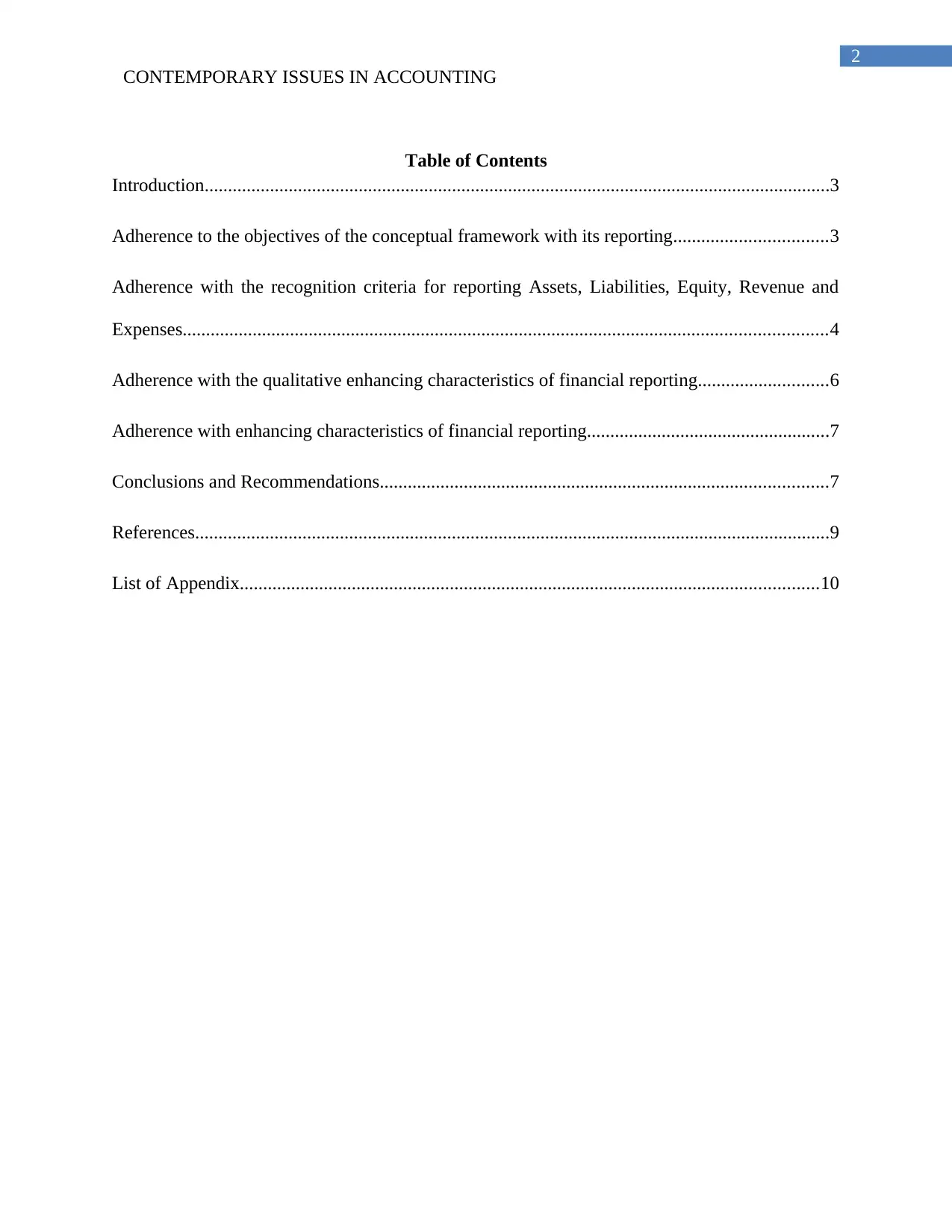
2
CONTEMPORARY ISSUES IN ACCOUNTING
Table of Contents
Introduction......................................................................................................................................3
Adherence to the objectives of the conceptual framework with its reporting.................................3
Adherence with the recognition criteria for reporting Assets, Liabilities, Equity, Revenue and
Expenses..........................................................................................................................................4
Adherence with the qualitative enhancing characteristics of financial reporting............................6
Adherence with enhancing characteristics of financial reporting....................................................7
Conclusions and Recommendations................................................................................................7
References........................................................................................................................................9
List of Appendix............................................................................................................................10
CONTEMPORARY ISSUES IN ACCOUNTING
Table of Contents
Introduction......................................................................................................................................3
Adherence to the objectives of the conceptual framework with its reporting.................................3
Adherence with the recognition criteria for reporting Assets, Liabilities, Equity, Revenue and
Expenses..........................................................................................................................................4
Adherence with the qualitative enhancing characteristics of financial reporting............................6
Adherence with enhancing characteristics of financial reporting....................................................7
Conclusions and Recommendations................................................................................................7
References........................................................................................................................................9
List of Appendix............................................................................................................................10
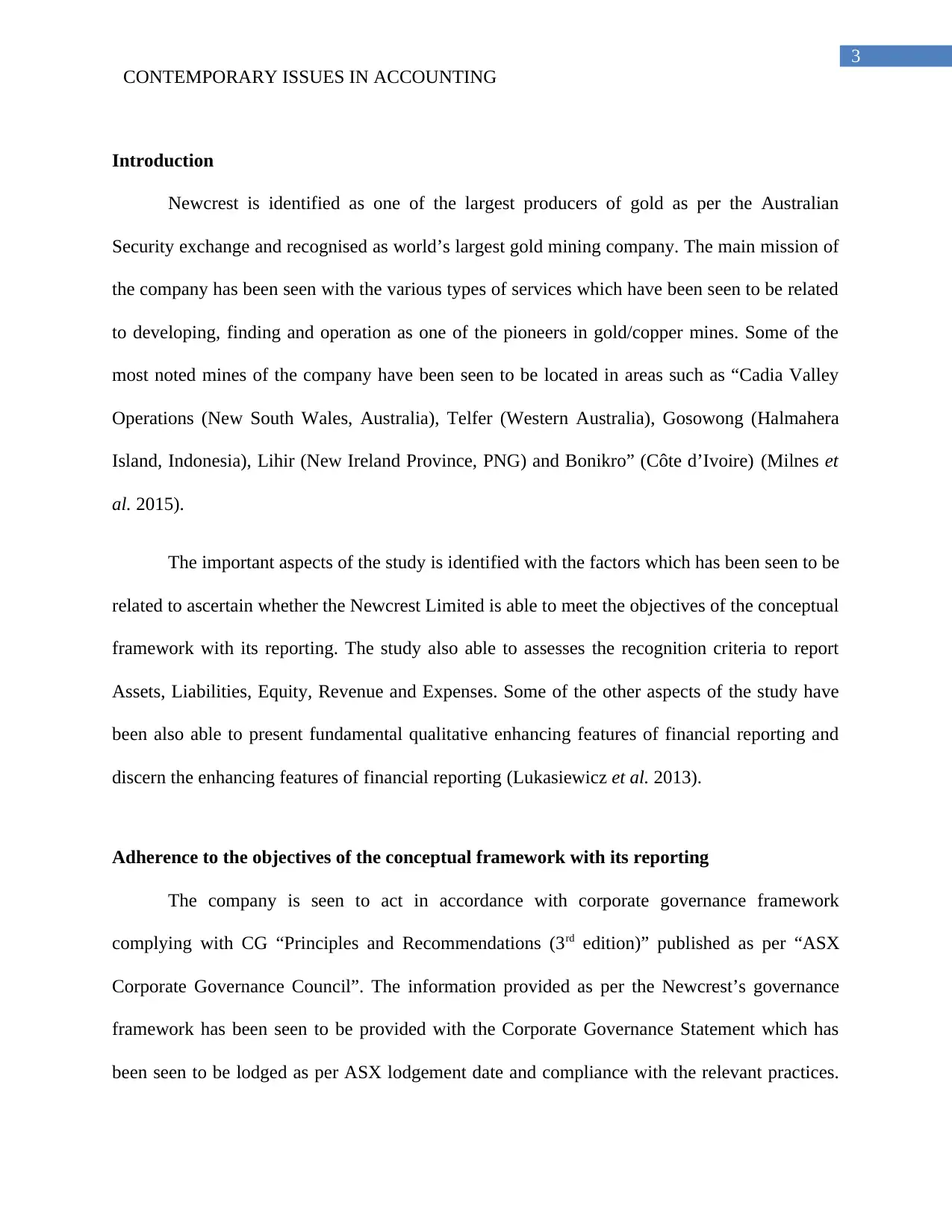
3
CONTEMPORARY ISSUES IN ACCOUNTING
Introduction
Newcrest is identified as one of the largest producers of gold as per the Australian
Security exchange and recognised as world’s largest gold mining company. The main mission of
the company has been seen with the various types of services which have been seen to be related
to developing, finding and operation as one of the pioneers in gold/copper mines. Some of the
most noted mines of the company have been seen to be located in areas such as “Cadia Valley
Operations (New South Wales, Australia), Telfer (Western Australia), Gosowong (Halmahera
Island, Indonesia), Lihir (New Ireland Province, PNG) and Bonikro” (Côte d’Ivoire) (Milnes et
al. 2015).
The important aspects of the study is identified with the factors which has been seen to be
related to ascertain whether the Newcrest Limited is able to meet the objectives of the conceptual
framework with its reporting. The study also able to assesses the recognition criteria to report
Assets, Liabilities, Equity, Revenue and Expenses. Some of the other aspects of the study have
been also able to present fundamental qualitative enhancing features of financial reporting and
discern the enhancing features of financial reporting (Lukasiewicz et al. 2013).
Adherence to the objectives of the conceptual framework with its reporting
The company is seen to act in accordance with corporate governance framework
complying with CG “Principles and Recommendations (3rd edition)” published as per “ASX
Corporate Governance Council”. The information provided as per the Newcrest’s governance
framework has been seen to be provided with the Corporate Governance Statement which has
been seen to be lodged as per ASX lodgement date and compliance with the relevant practices.
CONTEMPORARY ISSUES IN ACCOUNTING
Introduction
Newcrest is identified as one of the largest producers of gold as per the Australian
Security exchange and recognised as world’s largest gold mining company. The main mission of
the company has been seen with the various types of services which have been seen to be related
to developing, finding and operation as one of the pioneers in gold/copper mines. Some of the
most noted mines of the company have been seen to be located in areas such as “Cadia Valley
Operations (New South Wales, Australia), Telfer (Western Australia), Gosowong (Halmahera
Island, Indonesia), Lihir (New Ireland Province, PNG) and Bonikro” (Côte d’Ivoire) (Milnes et
al. 2015).
The important aspects of the study is identified with the factors which has been seen to be
related to ascertain whether the Newcrest Limited is able to meet the objectives of the conceptual
framework with its reporting. The study also able to assesses the recognition criteria to report
Assets, Liabilities, Equity, Revenue and Expenses. Some of the other aspects of the study have
been also able to present fundamental qualitative enhancing features of financial reporting and
discern the enhancing features of financial reporting (Lukasiewicz et al. 2013).
Adherence to the objectives of the conceptual framework with its reporting
The company is seen to act in accordance with corporate governance framework
complying with CG “Principles and Recommendations (3rd edition)” published as per “ASX
Corporate Governance Council”. The information provided as per the Newcrest’s governance
framework has been seen to be provided with the Corporate Governance Statement which has
been seen to be lodged as per ASX lodgement date and compliance with the relevant practices.
Secure Best Marks with AI Grader
Need help grading? Try our AI Grader for instant feedback on your assignments.
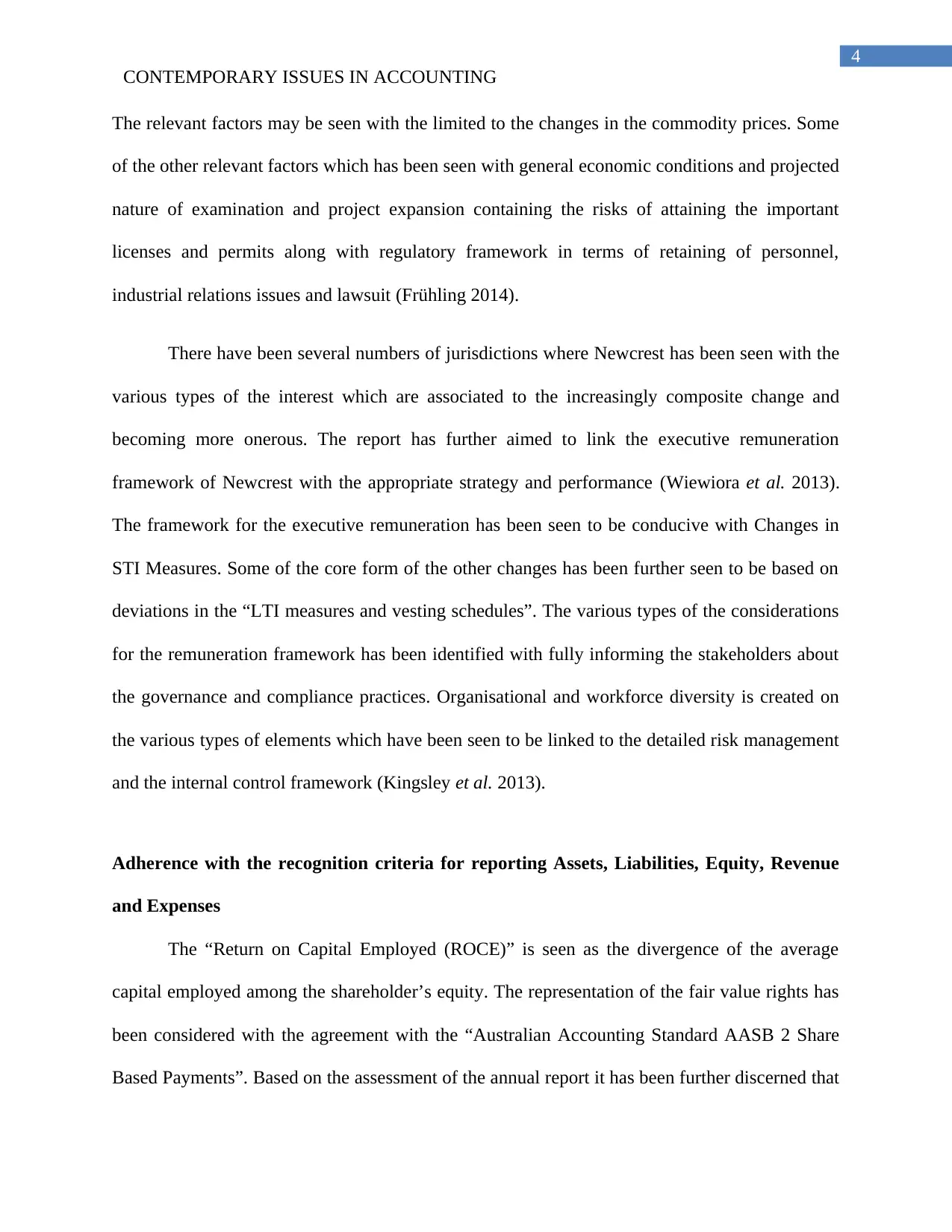
4
CONTEMPORARY ISSUES IN ACCOUNTING
The relevant factors may be seen with the limited to the changes in the commodity prices. Some
of the other relevant factors which has been seen with general economic conditions and projected
nature of examination and project expansion containing the risks of attaining the important
licenses and permits along with regulatory framework in terms of retaining of personnel,
industrial relations issues and lawsuit (Frühling 2014).
There have been several numbers of jurisdictions where Newcrest has been seen with the
various types of the interest which are associated to the increasingly composite change and
becoming more onerous. The report has further aimed to link the executive remuneration
framework of Newcrest with the appropriate strategy and performance (Wiewiora et al. 2013).
The framework for the executive remuneration has been seen to be conducive with Changes in
STI Measures. Some of the core form of the other changes has been further seen to be based on
deviations in the “LTI measures and vesting schedules”. The various types of the considerations
for the remuneration framework has been identified with fully informing the stakeholders about
the governance and compliance practices. Organisational and workforce diversity is created on
the various types of elements which have been seen to be linked to the detailed risk management
and the internal control framework (Kingsley et al. 2013).
Adherence with the recognition criteria for reporting Assets, Liabilities, Equity, Revenue
and Expenses
The “Return on Capital Employed (ROCE)” is seen as the divergence of the average
capital employed among the shareholder’s equity. The representation of the fair value rights has
been considered with the agreement with the “Australian Accounting Standard AASB 2 Share
Based Payments”. Based on the assessment of the annual report it has been further discerned that
CONTEMPORARY ISSUES IN ACCOUNTING
The relevant factors may be seen with the limited to the changes in the commodity prices. Some
of the other relevant factors which has been seen with general economic conditions and projected
nature of examination and project expansion containing the risks of attaining the important
licenses and permits along with regulatory framework in terms of retaining of personnel,
industrial relations issues and lawsuit (Frühling 2014).
There have been several numbers of jurisdictions where Newcrest has been seen with the
various types of the interest which are associated to the increasingly composite change and
becoming more onerous. The report has further aimed to link the executive remuneration
framework of Newcrest with the appropriate strategy and performance (Wiewiora et al. 2013).
The framework for the executive remuneration has been seen to be conducive with Changes in
STI Measures. Some of the core form of the other changes has been further seen to be based on
deviations in the “LTI measures and vesting schedules”. The various types of the considerations
for the remuneration framework has been identified with fully informing the stakeholders about
the governance and compliance practices. Organisational and workforce diversity is created on
the various types of elements which have been seen to be linked to the detailed risk management
and the internal control framework (Kingsley et al. 2013).
Adherence with the recognition criteria for reporting Assets, Liabilities, Equity, Revenue
and Expenses
The “Return on Capital Employed (ROCE)” is seen as the divergence of the average
capital employed among the shareholder’s equity. The representation of the fair value rights has
been considered with the agreement with the “Australian Accounting Standard AASB 2 Share
Based Payments”. Based on the assessment of the annual report it has been further discerned that
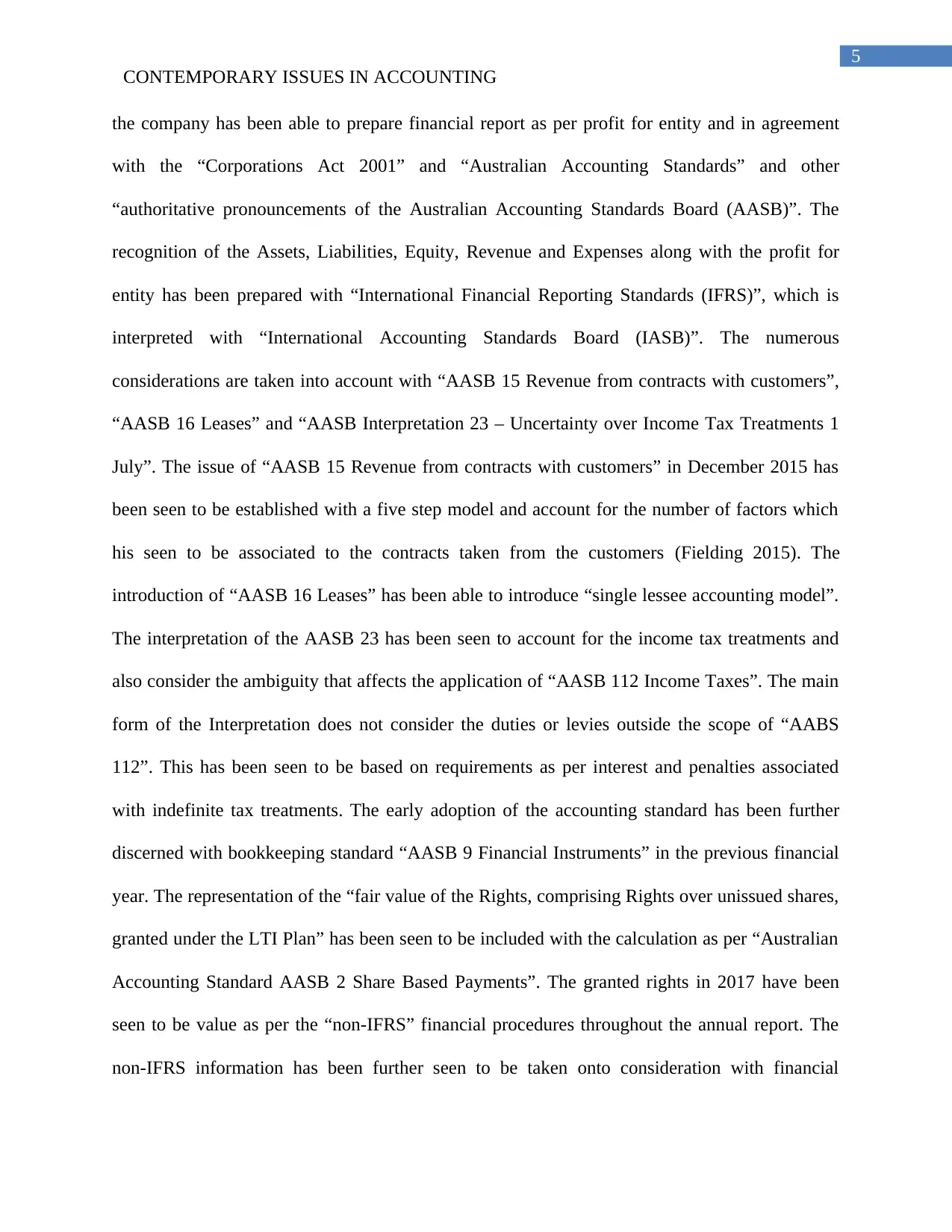
5
CONTEMPORARY ISSUES IN ACCOUNTING
the company has been able to prepare financial report as per profit for entity and in agreement
with the “Corporations Act 2001” and “Australian Accounting Standards” and other
“authoritative pronouncements of the Australian Accounting Standards Board (AASB)”. The
recognition of the Assets, Liabilities, Equity, Revenue and Expenses along with the profit for
entity has been prepared with “International Financial Reporting Standards (IFRS)”, which is
interpreted with “International Accounting Standards Board (IASB)”. The numerous
considerations are taken into account with “AASB 15 Revenue from contracts with customers”,
“AASB 16 Leases” and “AASB Interpretation 23 – Uncertainty over Income Tax Treatments 1
July”. The issue of “AASB 15 Revenue from contracts with customers” in December 2015 has
been seen to be established with a five step model and account for the number of factors which
his seen to be associated to the contracts taken from the customers (Fielding 2015). The
introduction of “AASB 16 Leases” has been able to introduce “single lessee accounting model”.
The interpretation of the AASB 23 has been seen to account for the income tax treatments and
also consider the ambiguity that affects the application of “AASB 112 Income Taxes”. The main
form of the Interpretation does not consider the duties or levies outside the scope of “AABS
112”. This has been seen to be based on requirements as per interest and penalties associated
with indefinite tax treatments. The early adoption of the accounting standard has been further
discerned with bookkeeping standard “AASB 9 Financial Instruments” in the previous financial
year. The representation of the “fair value of the Rights, comprising Rights over unissued shares,
granted under the LTI Plan” has been seen to be included with the calculation as per “Australian
Accounting Standard AASB 2 Share Based Payments”. The granted rights in 2017 have been
seen to be value as per the “non-IFRS” financial procedures throughout the annual report. The
non-IFRS information has been further seen to be taken onto consideration with financial
CONTEMPORARY ISSUES IN ACCOUNTING
the company has been able to prepare financial report as per profit for entity and in agreement
with the “Corporations Act 2001” and “Australian Accounting Standards” and other
“authoritative pronouncements of the Australian Accounting Standards Board (AASB)”. The
recognition of the Assets, Liabilities, Equity, Revenue and Expenses along with the profit for
entity has been prepared with “International Financial Reporting Standards (IFRS)”, which is
interpreted with “International Accounting Standards Board (IASB)”. The numerous
considerations are taken into account with “AASB 15 Revenue from contracts with customers”,
“AASB 16 Leases” and “AASB Interpretation 23 – Uncertainty over Income Tax Treatments 1
July”. The issue of “AASB 15 Revenue from contracts with customers” in December 2015 has
been seen to be established with a five step model and account for the number of factors which
his seen to be associated to the contracts taken from the customers (Fielding 2015). The
introduction of “AASB 16 Leases” has been able to introduce “single lessee accounting model”.
The interpretation of the AASB 23 has been seen to account for the income tax treatments and
also consider the ambiguity that affects the application of “AASB 112 Income Taxes”. The main
form of the Interpretation does not consider the duties or levies outside the scope of “AABS
112”. This has been seen to be based on requirements as per interest and penalties associated
with indefinite tax treatments. The early adoption of the accounting standard has been further
discerned with bookkeeping standard “AASB 9 Financial Instruments” in the previous financial
year. The representation of the “fair value of the Rights, comprising Rights over unissued shares,
granted under the LTI Plan” has been seen to be included with the calculation as per “Australian
Accounting Standard AASB 2 Share Based Payments”. The granted rights in 2017 have been
seen to be value as per the “non-IFRS” financial procedures throughout the annual report. The
non-IFRS information has been further seen to be taken onto consideration with financial
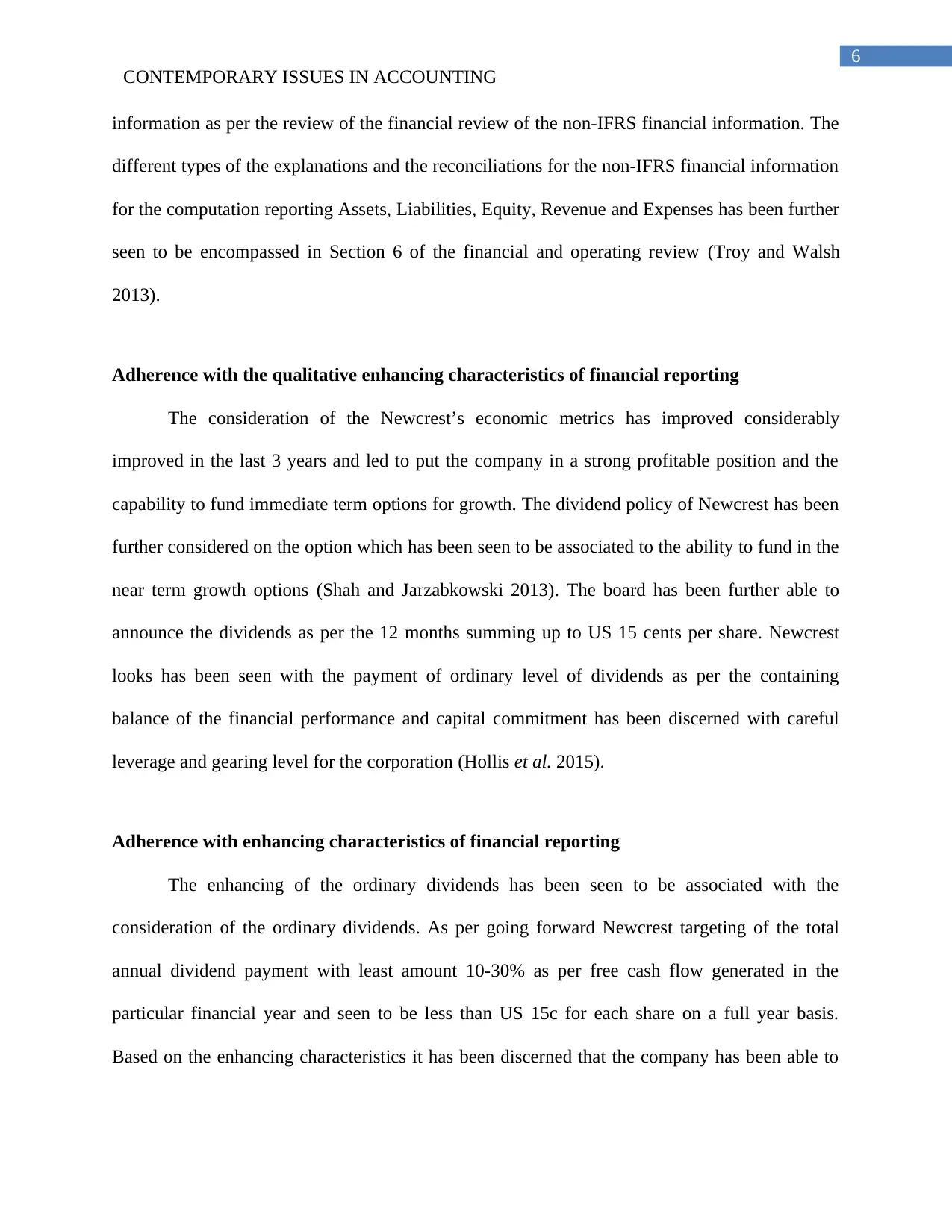
6
CONTEMPORARY ISSUES IN ACCOUNTING
information as per the review of the financial review of the non-IFRS financial information. The
different types of the explanations and the reconciliations for the non-IFRS financial information
for the computation reporting Assets, Liabilities, Equity, Revenue and Expenses has been further
seen to be encompassed in Section 6 of the financial and operating review (Troy and Walsh
2013).
Adherence with the qualitative enhancing characteristics of financial reporting
The consideration of the Newcrest’s economic metrics has improved considerably
improved in the last 3 years and led to put the company in a strong profitable position and the
capability to fund immediate term options for growth. The dividend policy of Newcrest has been
further considered on the option which has been seen to be associated to the ability to fund in the
near term growth options (Shah and Jarzabkowski 2013). The board has been further able to
announce the dividends as per the 12 months summing up to US 15 cents per share. Newcrest
looks has been seen with the payment of ordinary level of dividends as per the containing
balance of the financial performance and capital commitment has been discerned with careful
leverage and gearing level for the corporation (Hollis et al. 2015).
Adherence with enhancing characteristics of financial reporting
The enhancing of the ordinary dividends has been seen to be associated with the
consideration of the ordinary dividends. As per going forward Newcrest targeting of the total
annual dividend payment with least amount 10-30% as per free cash flow generated in the
particular financial year and seen to be less than US 15c for each share on a full year basis.
Based on the enhancing characteristics it has been discerned that the company has been able to
CONTEMPORARY ISSUES IN ACCOUNTING
information as per the review of the financial review of the non-IFRS financial information. The
different types of the explanations and the reconciliations for the non-IFRS financial information
for the computation reporting Assets, Liabilities, Equity, Revenue and Expenses has been further
seen to be encompassed in Section 6 of the financial and operating review (Troy and Walsh
2013).
Adherence with the qualitative enhancing characteristics of financial reporting
The consideration of the Newcrest’s economic metrics has improved considerably
improved in the last 3 years and led to put the company in a strong profitable position and the
capability to fund immediate term options for growth. The dividend policy of Newcrest has been
further considered on the option which has been seen to be associated to the ability to fund in the
near term growth options (Shah and Jarzabkowski 2013). The board has been further able to
announce the dividends as per the 12 months summing up to US 15 cents per share. Newcrest
looks has been seen with the payment of ordinary level of dividends as per the containing
balance of the financial performance and capital commitment has been discerned with careful
leverage and gearing level for the corporation (Hollis et al. 2015).
Adherence with enhancing characteristics of financial reporting
The enhancing of the ordinary dividends has been seen to be associated with the
consideration of the ordinary dividends. As per going forward Newcrest targeting of the total
annual dividend payment with least amount 10-30% as per free cash flow generated in the
particular financial year and seen to be less than US 15c for each share on a full year basis.
Based on the enhancing characteristics it has been discerned that the company has been able to
Paraphrase This Document
Need a fresh take? Get an instant paraphrase of this document with our AI Paraphraser
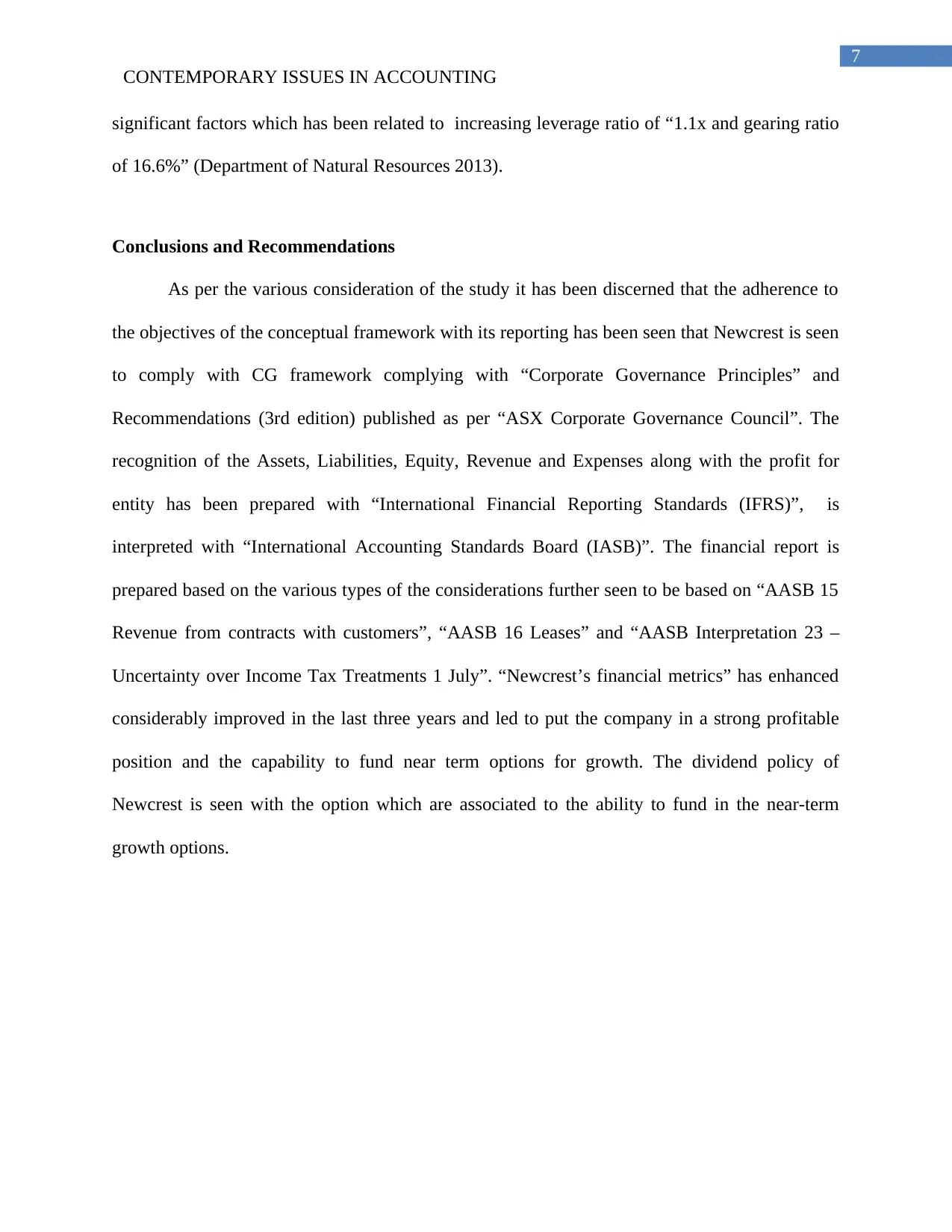
7
CONTEMPORARY ISSUES IN ACCOUNTING
significant factors which has been related to increasing leverage ratio of “1.1x and gearing ratio
of 16.6%” (Department of Natural Resources 2013).
Conclusions and Recommendations
As per the various consideration of the study it has been discerned that the adherence to
the objectives of the conceptual framework with its reporting has been seen that Newcrest is seen
to comply with CG framework complying with “Corporate Governance Principles” and
Recommendations (3rd edition) published as per “ASX Corporate Governance Council”. The
recognition of the Assets, Liabilities, Equity, Revenue and Expenses along with the profit for
entity has been prepared with “International Financial Reporting Standards (IFRS)”, is
interpreted with “International Accounting Standards Board (IASB)”. The financial report is
prepared based on the various types of the considerations further seen to be based on “AASB 15
Revenue from contracts with customers”, “AASB 16 Leases” and “AASB Interpretation 23 –
Uncertainty over Income Tax Treatments 1 July”. “Newcrest’s financial metrics” has enhanced
considerably improved in the last three years and led to put the company in a strong profitable
position and the capability to fund near term options for growth. The dividend policy of
Newcrest is seen with the option which are associated to the ability to fund in the near-term
growth options.
CONTEMPORARY ISSUES IN ACCOUNTING
significant factors which has been related to increasing leverage ratio of “1.1x and gearing ratio
of 16.6%” (Department of Natural Resources 2013).
Conclusions and Recommendations
As per the various consideration of the study it has been discerned that the adherence to
the objectives of the conceptual framework with its reporting has been seen that Newcrest is seen
to comply with CG framework complying with “Corporate Governance Principles” and
Recommendations (3rd edition) published as per “ASX Corporate Governance Council”. The
recognition of the Assets, Liabilities, Equity, Revenue and Expenses along with the profit for
entity has been prepared with “International Financial Reporting Standards (IFRS)”, is
interpreted with “International Accounting Standards Board (IASB)”. The financial report is
prepared based on the various types of the considerations further seen to be based on “AASB 15
Revenue from contracts with customers”, “AASB 16 Leases” and “AASB Interpretation 23 –
Uncertainty over Income Tax Treatments 1 July”. “Newcrest’s financial metrics” has enhanced
considerably improved in the last three years and led to put the company in a strong profitable
position and the capability to fund near term options for growth. The dividend policy of
Newcrest is seen with the option which are associated to the ability to fund in the near-term
growth options.
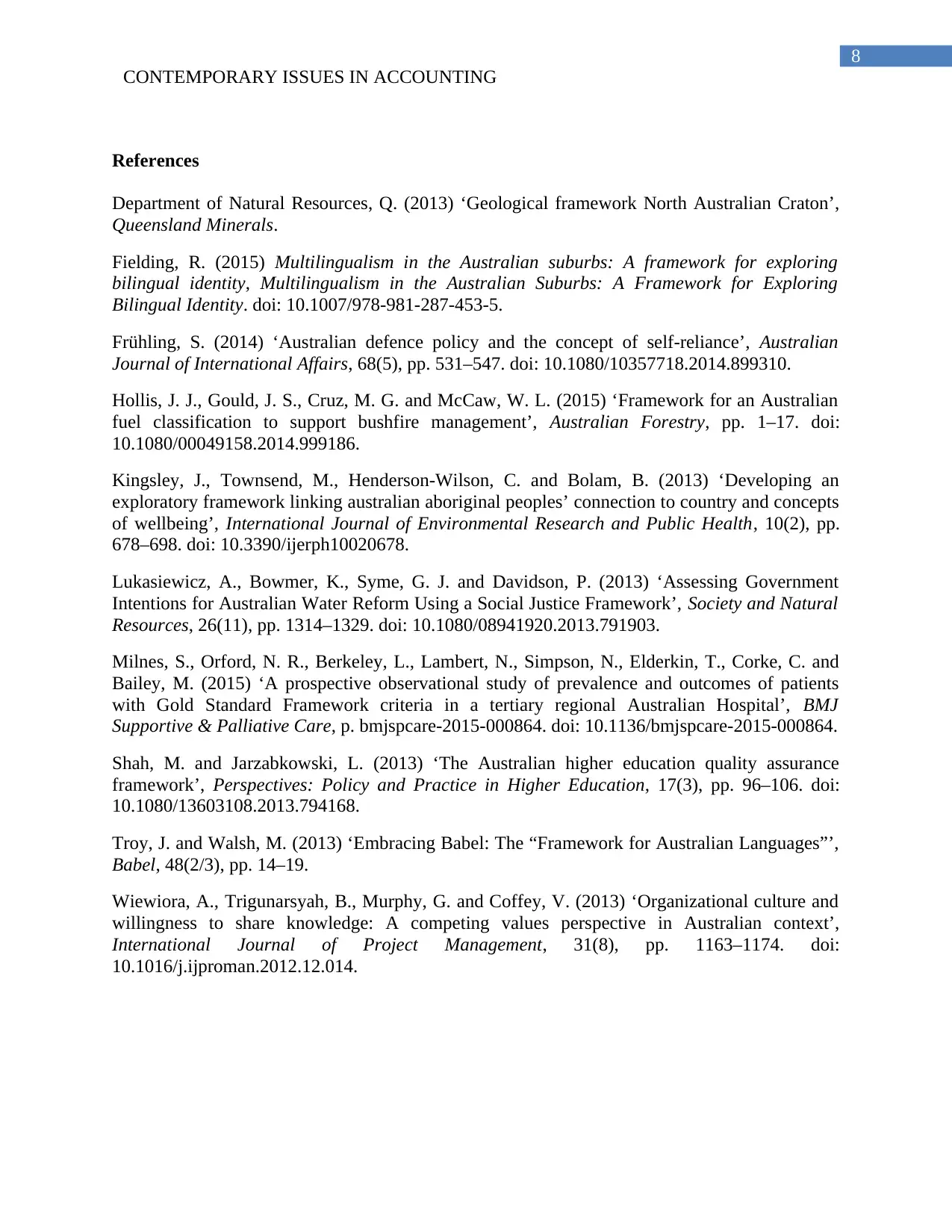
8
CONTEMPORARY ISSUES IN ACCOUNTING
References
Department of Natural Resources, Q. (2013) ‘Geological framework North Australian Craton’,
Queensland Minerals.
Fielding, R. (2015) Multilingualism in the Australian suburbs: A framework for exploring
bilingual identity, Multilingualism in the Australian Suburbs: A Framework for Exploring
Bilingual Identity. doi: 10.1007/978-981-287-453-5.
Frühling, S. (2014) ‘Australian defence policy and the concept of self-reliance’, Australian
Journal of International Affairs, 68(5), pp. 531–547. doi: 10.1080/10357718.2014.899310.
Hollis, J. J., Gould, J. S., Cruz, M. G. and McCaw, W. L. (2015) ‘Framework for an Australian
fuel classification to support bushfire management’, Australian Forestry, pp. 1–17. doi:
10.1080/00049158.2014.999186.
Kingsley, J., Townsend, M., Henderson-Wilson, C. and Bolam, B. (2013) ‘Developing an
exploratory framework linking australian aboriginal peoples’ connection to country and concepts
of wellbeing’, International Journal of Environmental Research and Public Health, 10(2), pp.
678–698. doi: 10.3390/ijerph10020678.
Lukasiewicz, A., Bowmer, K., Syme, G. J. and Davidson, P. (2013) ‘Assessing Government
Intentions for Australian Water Reform Using a Social Justice Framework’, Society and Natural
Resources, 26(11), pp. 1314–1329. doi: 10.1080/08941920.2013.791903.
Milnes, S., Orford, N. R., Berkeley, L., Lambert, N., Simpson, N., Elderkin, T., Corke, C. and
Bailey, M. (2015) ‘A prospective observational study of prevalence and outcomes of patients
with Gold Standard Framework criteria in a tertiary regional Australian Hospital’, BMJ
Supportive & Palliative Care, p. bmjspcare-2015-000864. doi: 10.1136/bmjspcare-2015-000864.
Shah, M. and Jarzabkowski, L. (2013) ‘The Australian higher education quality assurance
framework’, Perspectives: Policy and Practice in Higher Education, 17(3), pp. 96–106. doi:
10.1080/13603108.2013.794168.
Troy, J. and Walsh, M. (2013) ‘Embracing Babel: The “Framework for Australian Languages”’,
Babel, 48(2/3), pp. 14–19.
Wiewiora, A., Trigunarsyah, B., Murphy, G. and Coffey, V. (2013) ‘Organizational culture and
willingness to share knowledge: A competing values perspective in Australian context’,
International Journal of Project Management, 31(8), pp. 1163–1174. doi:
10.1016/j.ijproman.2012.12.014.
CONTEMPORARY ISSUES IN ACCOUNTING
References
Department of Natural Resources, Q. (2013) ‘Geological framework North Australian Craton’,
Queensland Minerals.
Fielding, R. (2015) Multilingualism in the Australian suburbs: A framework for exploring
bilingual identity, Multilingualism in the Australian Suburbs: A Framework for Exploring
Bilingual Identity. doi: 10.1007/978-981-287-453-5.
Frühling, S. (2014) ‘Australian defence policy and the concept of self-reliance’, Australian
Journal of International Affairs, 68(5), pp. 531–547. doi: 10.1080/10357718.2014.899310.
Hollis, J. J., Gould, J. S., Cruz, M. G. and McCaw, W. L. (2015) ‘Framework for an Australian
fuel classification to support bushfire management’, Australian Forestry, pp. 1–17. doi:
10.1080/00049158.2014.999186.
Kingsley, J., Townsend, M., Henderson-Wilson, C. and Bolam, B. (2013) ‘Developing an
exploratory framework linking australian aboriginal peoples’ connection to country and concepts
of wellbeing’, International Journal of Environmental Research and Public Health, 10(2), pp.
678–698. doi: 10.3390/ijerph10020678.
Lukasiewicz, A., Bowmer, K., Syme, G. J. and Davidson, P. (2013) ‘Assessing Government
Intentions for Australian Water Reform Using a Social Justice Framework’, Society and Natural
Resources, 26(11), pp. 1314–1329. doi: 10.1080/08941920.2013.791903.
Milnes, S., Orford, N. R., Berkeley, L., Lambert, N., Simpson, N., Elderkin, T., Corke, C. and
Bailey, M. (2015) ‘A prospective observational study of prevalence and outcomes of patients
with Gold Standard Framework criteria in a tertiary regional Australian Hospital’, BMJ
Supportive & Palliative Care, p. bmjspcare-2015-000864. doi: 10.1136/bmjspcare-2015-000864.
Shah, M. and Jarzabkowski, L. (2013) ‘The Australian higher education quality assurance
framework’, Perspectives: Policy and Practice in Higher Education, 17(3), pp. 96–106. doi:
10.1080/13603108.2013.794168.
Troy, J. and Walsh, M. (2013) ‘Embracing Babel: The “Framework for Australian Languages”’,
Babel, 48(2/3), pp. 14–19.
Wiewiora, A., Trigunarsyah, B., Murphy, G. and Coffey, V. (2013) ‘Organizational culture and
willingness to share knowledge: A competing values perspective in Australian context’,
International Journal of Project Management, 31(8), pp. 1163–1174. doi:
10.1016/j.ijproman.2012.12.014.
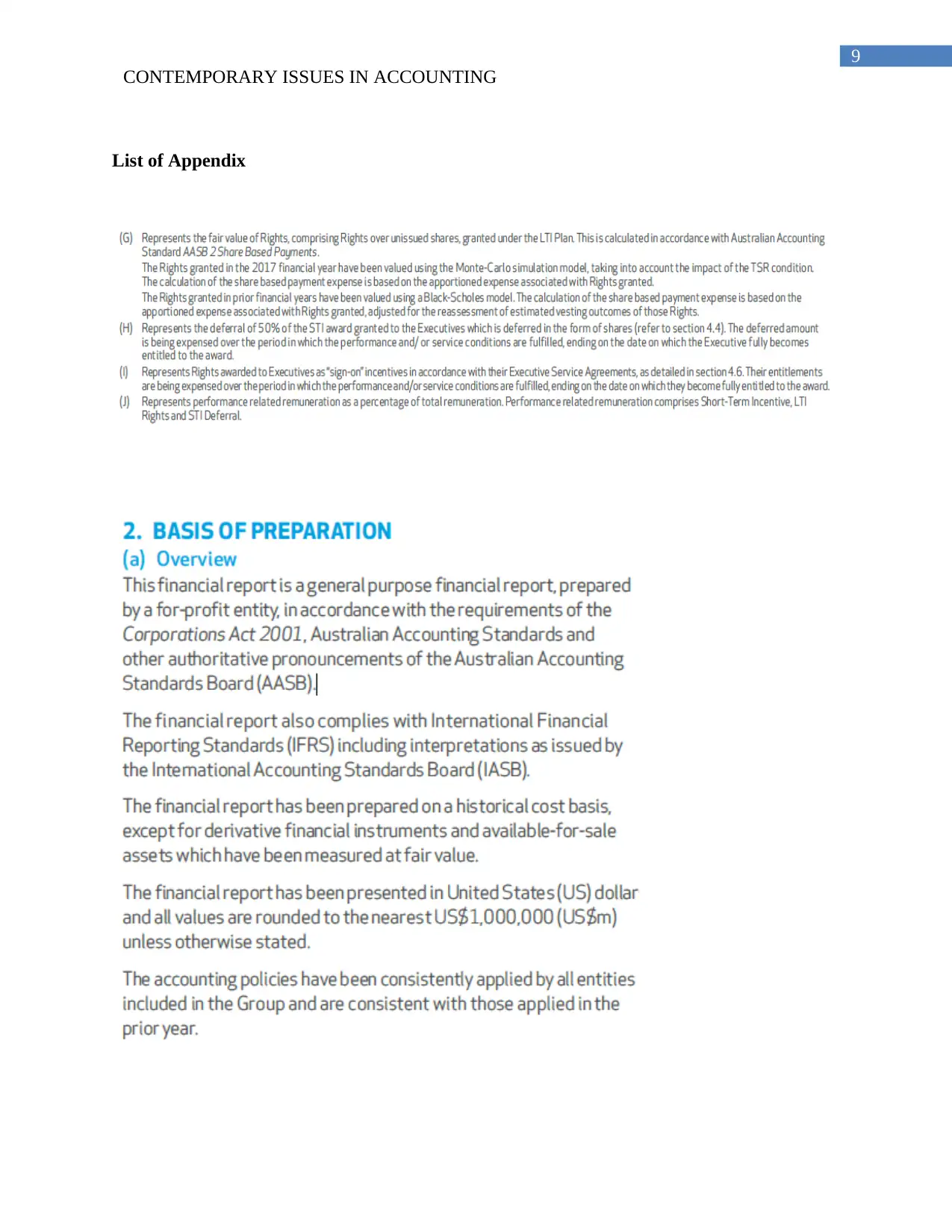
9
CONTEMPORARY ISSUES IN ACCOUNTING
List of Appendix
CONTEMPORARY ISSUES IN ACCOUNTING
List of Appendix
Secure Best Marks with AI Grader
Need help grading? Try our AI Grader for instant feedback on your assignments.
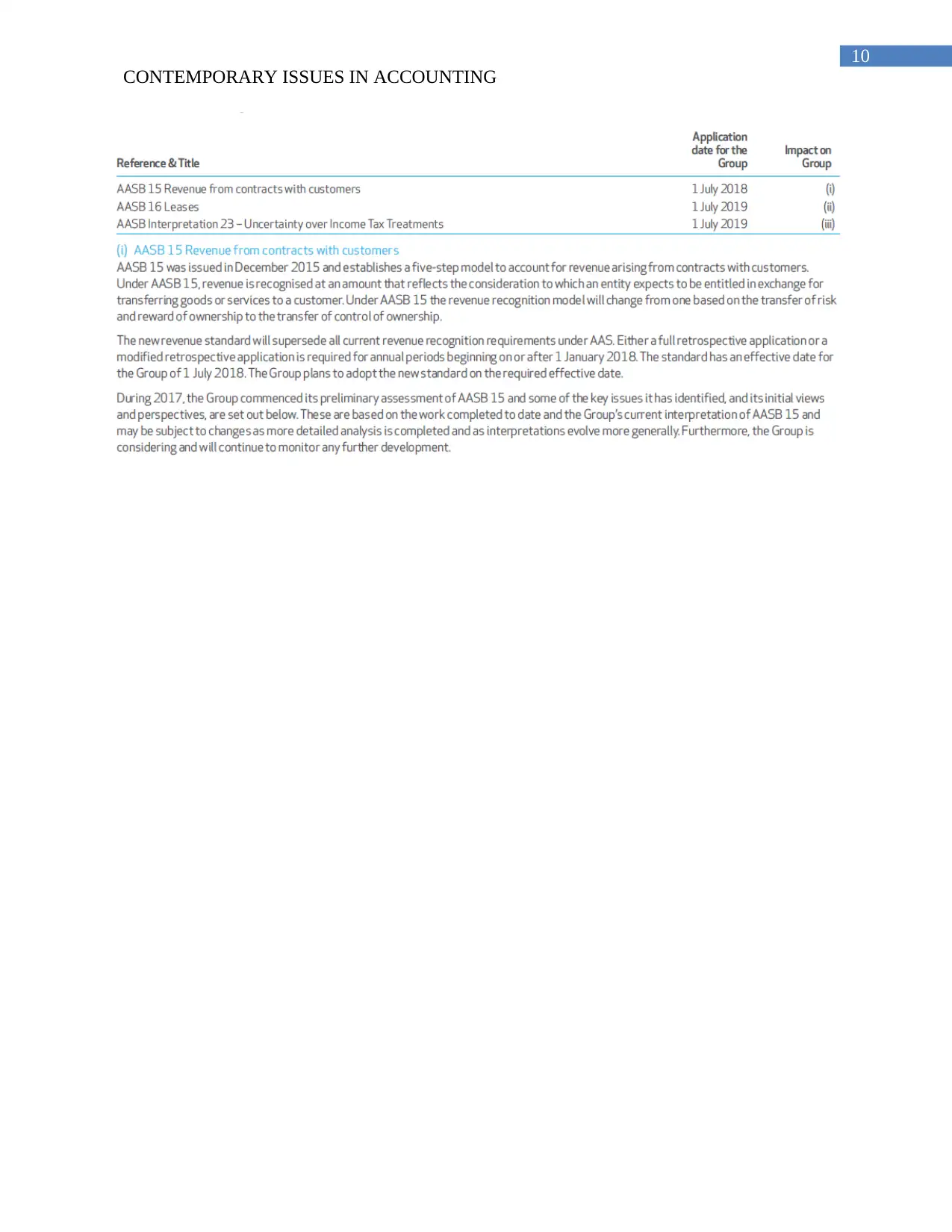
10
CONTEMPORARY ISSUES IN ACCOUNTING
CONTEMPORARY ISSUES IN ACCOUNTING
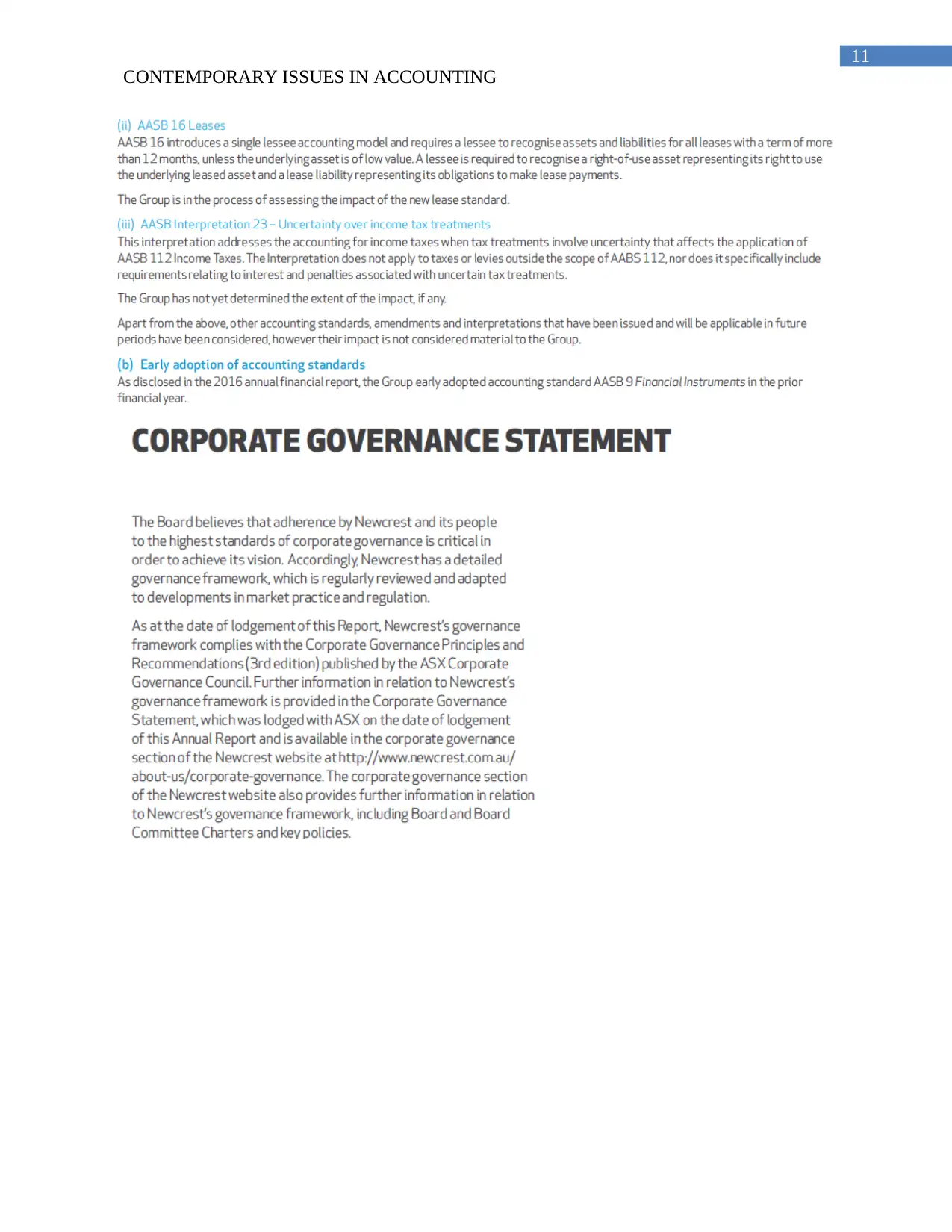
11
CONTEMPORARY ISSUES IN ACCOUNTING
CONTEMPORARY ISSUES IN ACCOUNTING
1 out of 12
Related Documents
Your All-in-One AI-Powered Toolkit for Academic Success.
+13062052269
info@desklib.com
Available 24*7 on WhatsApp / Email
![[object Object]](/_next/static/media/star-bottom.7253800d.svg)
Unlock your academic potential
© 2024 | Zucol Services PVT LTD | All rights reserved.


